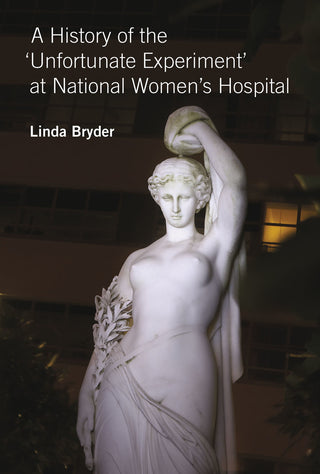A History of the 'Unfortunate Experiment' at National Women's Hospital
- Unit price
- / per
-
Author:Linda Bryder
-
ISBN:9781869404352
-
Publication Date:August 2009
-
Edition:1
-
Pages:250
-
Binding:Paperback
-
Publisher:Auckland University Press
-
Country of Publication:New Zealand


A Back Order button means that we don’t have the book in stock at our store. It may already be on order – or we can order it for you from a publisher or distributor at no additional cost.
As we source items from around the globe, a back-order can take anywhere from 5 days to several weeks to arrive, depending on the title.
To check how long this might take, you’re welcome to contact us and we can provide an ETA or any other information you need. We recommend checking the timeframe before committing to an online order.
A History of the 'Unfortunate Experiment' at National Women's Hospital
- Unit price
- / per
-
Author:Linda Bryder
-
ISBN:9781869404352
-
Publication Date:August 2009
-
Edition:1
-
Pages:250
-
Binding:Paperback
-
Publisher:Auckland University Press
-
Country of Publication:New Zealand
Description
In the late 1980s, a national outcry followed the publication of Sandra Coney and Phillida Bunkle’s ‘Unfortunate Experiment’ article in Metro magazine about the treatment of carcinoma in situ at National Women’s Hospital. The article prompted a commission of inquiry led by Judge Silvia Cartwright which indicted the practices of doctors at the hospital and led to lawsuits, censure, a national screening programme and a revolution in doctor–patient relations in New Zealand.
In this carefully researched book, medical historian Dr Linda Bryder provides a detailed analysis of the treatment of carcinoma in situ at National Women’s since the 1950s, an assessment of international medical practice and a history of the women’s health movement. She tackles a number of key questions. Was treatment at National Women’s an ‘unfortunate experiment’? Was it out of line with international norms? Did Herb Green and his colleagues care more for science than for their patients? Did women die as a result? And what were the sources of the scandal that erupted?
Adding product to your cart
You may also like
A Back Order button means that we don’t have the book in stock at our store. It may already be on order – or we can order it for you from a publisher or distributor at no additional cost.
As we source items from around the globe, a back-order can take anywhere from 5 days to several weeks to arrive, depending on the title.
To check how long this might take, you’re welcome to contact us and we can provide an ETA or any other information you need. We recommend checking the timeframe before committing to an online order.
You may also like
You may also like
-
In the late 1980s, a national outcry followed the publication of Sandra Coney and Phillida Bunkle’s ‘Unfortunate Experiment’ article in Metro magazine about the treatment of carcinoma in situ at National Women’s Hospital. The article prompted a commission of inquiry led by Judge Silvia Cartwright which indicted the practices of doctors at the hospital and led to lawsuits, censure, a national screening programme and a revolution in doctor–patient relations in New Zealand.
In this carefully researched book, medical historian Dr Linda Bryder provides a detailed analysis of the treatment of carcinoma in situ at National Women’s since the 1950s, an assessment of international medical practice and a history of the women’s health movement. She tackles a number of key questions. Was treatment at National Women’s an ‘unfortunate experiment’? Was it out of line with international norms? Did Herb Green and his colleagues care more for science than for their patients? Did women die as a result? And what were the sources of the scandal that erupted?
-
-
Author: Linda BryderISBN: 9781869404352Publication Date: August 2009Edition: 1Pages: 250Binding: PaperbackPublisher: Auckland University PressCountry of Publication: New Zealand
In the late 1980s, a national outcry followed the publication of Sandra Coney and Phillida Bunkle’s ‘Unfortunate Experiment’ article in Metro magazine about the treatment of carcinoma in situ at National Women’s Hospital. The article prompted a commission of inquiry led by Judge Silvia Cartwright which indicted the practices of doctors at the hospital and led to lawsuits, censure, a national screening programme and a revolution in doctor–patient relations in New Zealand.
In this carefully researched book, medical historian Dr Linda Bryder provides a detailed analysis of the treatment of carcinoma in situ at National Women’s since the 1950s, an assessment of international medical practice and a history of the women’s health movement. She tackles a number of key questions. Was treatment at National Women’s an ‘unfortunate experiment’? Was it out of line with international norms? Did Herb Green and his colleagues care more for science than for their patients? Did women die as a result? And what were the sources of the scandal that erupted?
-
Author: Linda BryderISBN: 9781869404352Publication Date: August 2009Edition: 1Pages: 250Binding: PaperbackPublisher: Auckland University PressCountry of Publication: New Zealand
-



